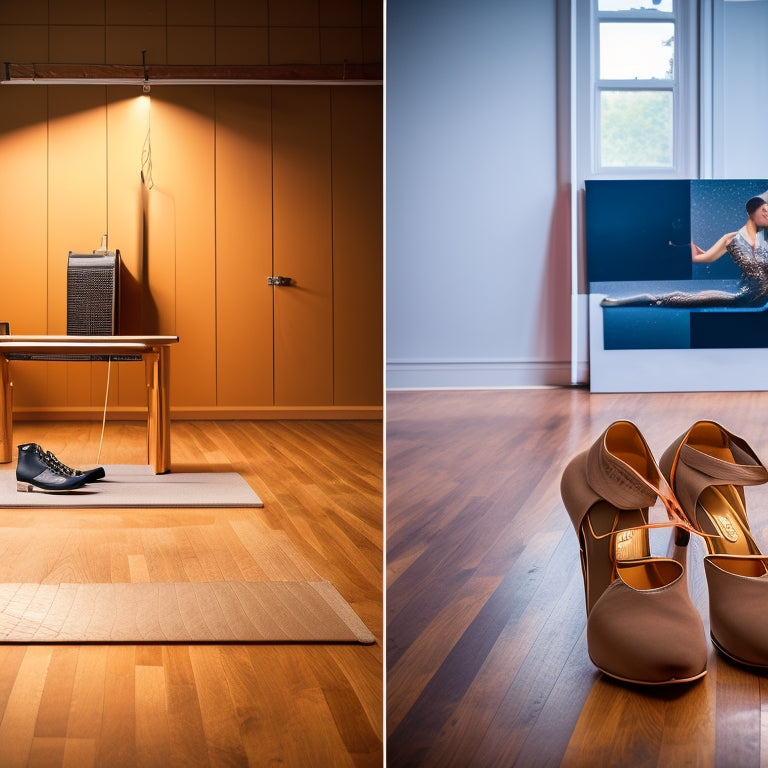
Can You Use Plywood as a Dance Floor?
Share
When considering plywood as a dance floor, you'll want to weigh its durability and safety against heavy foot traffic. Plywood grading, density, and proper maintenance are important to prevent slip and fall risks. Regular cleaning, non-slip coatings, and proper footwear can enhance safety. Plywood's affordability and quick installation make it an attractive option, but it's vital to also consider weight capacity, moisture management, and slip resistance. As you assess plywood's suitability, you'll want to examine these factors in more depth to guarantee a safe and functional dance floor that meets your needs.
Key Takeaways
• Plywood can be used as a dance floor, but its durability and safety depend on factors like grading, density, and foot traffic patterns.
• Weight capacity and crowd size must be considered, as plywood thickness, type, and floor joist span impact the floor's ability to support dancers.
• Proper sealing, coating, and consistent environment control are crucial to mitigate risks associated with moisture and maintain plywood quality.
• Slip resistance can be improved with coatings and surface roughness, and regular cleaning and maintenance are necessary to prevent accidents.
• While plywood is an affordable option, alternatives like modular flooring systems and sprung floors offer durability and a high-quality dancing experience.
Durability of Plywood Under Foot
When subjected to repetitive foot traffic and dynamic movements, plywood's durability underfoot becomes a crucial consideration, as its performance directly impacts the safety and enjoyment of dancers.
You'll want to make sure your plywood is up to the task. Plywood grading plays a critical role in determining its durability. Look for high-grade plywood with a dense, consistent core, as it will better withstand the demands of frequent use.
Additionally, consider the foot traffic patterns of your dancers. Will they be performing high-impact movements or gentle gestures? Understanding these patterns will help you choose the right plywood for your needs.
Safety Concerns for Dancers
When you're dancing on a plywood floor, you'll want to take into account the potential safety risks.
You're likely to be concerned about slipping and falling, especially if the floor is worn or damaged.
Additionally, you'll need to evaluate the durability of the flooring material itself, as a weak or compromised floor can lead to injuries.
Slip and Fall Risks
You face a significant risk of slipping and falling on a plywood dance floor, particularly if it's not properly treated or maintained. This is a major safety concern, as a single slip can lead to serious injuries. To minimize this risk, it's essential to implement regular floor cleaning and maintenance routines. Failure to do so can result in accident liability, which can have severe consequences for dancers, instructors, and studio owners.
| Slip and Fall Risk Factors | Mitigation Strategies |
|---|---|
| Inadequate floor cleaning | Implement regular cleaning schedules |
| Insufficient floor treatment | Apply non-slip coatings or finishes |
| Poor floor maintenance | Perform regular inspections and repairs |
| Inadequate footwear | Wear dance shoes with non-slip soles |
Flooring Material Durability
As dancers repeatedly jump, spin, and land on a plywood dance floor, the material's importance becomes a critical safety concern, since a worn-out floor can lead to injuries and accidents. You need to guarantee the plywood can withstand the high-impact movements, as a brittle or weakened floor can collapse or splinter, causing harm.
A durable plywood floor is essential, not only for safety but also for maintaining its aesthetic appeal. Additionally, considering the environmental impact, a long-lasting floor reduces the need for frequent replacements, minimizing waste and the carbon footprint.
Weight Capacity and Crowd Size
How much weight can your plywood dance floor safely support, and what's the maximum crowd size it can handle before structural integrity becomes a concern?
As an event planner, understanding the weight capacity of your dance floor is pivotal to guarantee a safe and enjoyable experience for your guests. When it comes to crowd dynamics, it's imperative to take into account the density of the crowd and the weight distribution on the floor.
Here are some key factors to bear in mind when evaluating the weight capacity and crowd size of your plywood dance floor:
- The thickness and type of plywood used
- The span of the floor joists and their spacing
- The weight of the flooring material itself
- The overall design and construction of the floor
Moisture and Humidity Issues
Plywood dance floors are particularly susceptible to moisture and humidity issues, which can compromise their structural integrity and overall performance. When considering using plywood for your dance floor, addressing these concerns becomes crucial.
Wood rot, a common issue in humid environments, can weaken the plywood, making it unsafe for use. Warped panels are another concern, as excess moisture can cause the plywood to bend or curve, creating an uneven surface. To mitigate these issues, you should make sure your plywood is properly sealed and coated to prevent moisture absorption.
Additionally, maintaining a consistent and controlled environment can help prevent moisture-related problems. By taking these precautions, you can minimize the risks associated with moisture and humidity, ensuring a safe and durable dance floor.
Slip Resistance and Coatings
As you consider plywood for your dance floor, you'll need to evaluate its slip resistance to guarantee a safe environment for dancers.
To do this, you'll want to conduct grip and traction tests to determine the floor's coefficient of friction.
Next, you'll explore coating options and floor finishing choices to enhance slip resistance and achieve the desired level of traction.
Grip and Traction Tests
You'll need to evaluate the slip resistance of your plywood dance floor by conducting grip and traction tests to guarantee a safe and stable surface for dancers. This is essential to prevent slips, trips, and falls that can lead to injuries.
To make sure you have the best grip and traction, consider the following factors:
-
Surface roughness: A rougher surface provides better grip, but may be uncomfortable for dancers. Find a balance between grip and comfort.
-
Material pairing: Combine plywood with materials that enhance grip, such as textured coatings or rubber matting.
-
Moisture resistance: Ensure your plywood dance floor can withstand spills and humidity to maintain traction.
- Dynamic coefficient of friction: Measure the floor's ability to resist slipping when exposed to dance movements and footwear.
Coating Options Compared
What coating options can provide the best balance of slip resistance and aesthetic appeal for your dance floor?
When choosing a coating, consider the trade-off between traction and visual appeal. Polyurethane-based coatings offer excellent slip resistance but may compromise on color options.
Epoxy-based coatings, on the other hand, provide a wide range of color options but may not offer the same level of grip. Acrylic coatings strike a balance between the two, offering moderate slip resistance and a variety of color options.
When selecting a coating, consider your dance style, foot traffic, and desired aesthetic appeal. By weighing these factors, you can find a coating that meets your needs for both safety and visual appeal.
Floor Finishing Choices
When finishing your plywood dance floor, selecting the ideal combination of slip resistance and coating is essential to guarantee a safe and visually appealing surface that meets your specific needs. You want a floor that not only looks great but also provides the necessary traction to prevent slips and falls.
Some key considerations for your floor finishing choices include:
-
Aesthetic appeal: Choosing a coating that complements your dance floor's design and style.
-
Design flexibility: Selecting a coating that can be customized to fit your unique needs and preferences.
-
Slip resistance ratings: Ensuring your chosen coating meets or exceeds industry standards for slip resistance.
- Durability and maintenance: Considering the long-term performance and upkeep requirements of your chosen coating.
Cost Comparison to Alternatives
Comparing the cost of a plywood dance floor to its alternatives reveals significant differences, with some options, such as sprung floors, carrying a price tag up to five times higher. When you factor in the cost of materials, labor, and installation, plywood emerges as a more affordable option.
A key factor in this cost difference is the supply chain and material sourcing. Plywood is widely available and can be sourced from local suppliers, reducing transportation costs and lead times. In contrast, specialized dance floor materials often require longer lead times and more complex logistics, driving up costs.
Installation and Removal Ease
You'll find that installing a plywood dance floor is a relatively straightforward process that requires minimal specialized labor, reducing the overall installation cost and complexity. This ease of installation saves you time and money, allowing you to focus on other aspects of your event or performance.
When it's time to remove the floor, you'll appreciate the efficient disassembly process, which utilizes time-saving techniques to minimize downtime.
Some benefits of plywood dance floor installation and removal include:
- Quick and easy assembly and disassembly
- Minimal labor costs and requirements
- Reduced installation and removal time
- Efficient use of resources, allowing for more freedom to focus on other aspects of your event
Maintenance and Repair Needs
Your plywood dance floor requires periodic inspections and maintenance to guarantee its longevity and peak performance, and you should be prepared to address occasional repairs as needed.
Regularly check for signs of wear, such as scratches or dents, and perform damage assessments to identify areas that need attention.
Aesthetic updates, like refinishing or revarnishing, can help maintain the floor's appearance and extend its lifespan.
When repairs are necessary, prioritize them to prevent further damage.
By staying proactive, you'll make sure your plywood dance floor remains safe, functional, and visually appealing.
Alternatives for a Permanent Floor
When opting for a more permanent dance floor solution, consider alternatives that offer improved durability and stability. Modular flooring systems or sprung floors can provide a more reliable and long-lasting performance surface. These options can be more expensive than plywood but they provide a higher quality dancing experience.
If you're looking for a more flexible solution, consider temporary rentals or portable staging options that can be easily set up and taken down.
-
Modular flooring systems for a durable and long-lasting surface
-
Sprung floors for a high-quality dancing experience
-
Temporary rentals for a flexible and affordable solution
-
Portable staging for easy setup and takedown
Frequently Asked Questions
Can You Use Plywood as a Dance Floor for Outdoor Events?
"Your outdoor event is a canvas waiting for art, but can plywood be the ideal dance floor? Yes, if you choose weather-resistant plywood, compatible with your tent's framework, ensuring a sturdy and safe dance space under the open sky."
How Do You Clean and Disinfect a Plywood Dance Floor?
To maintain your plywood dance floor, you'll need to perform daily maintenance, sweeping and mopping regularly, and applying floor finishes periodically to safeguard the surface and guarantee a safe, clean, and enjoyable dancing experience.
Are There Specific Types of Plywood Recommended for Dance Floors?
When selecting plywood for your dance floor, you'll want to prioritize high-density panels with a smooth, even surface, opting for grades like BB or CC, which offer superior durability and resistance to wear and tear.
Can Plywood Dance Floors Be Used for High-Impact Dance Styles?
'When you engage in high-impact dance styles, you'll want to make sure your plywood floor can withstand the force; wear dance shoes with non-marking soles and consider adding a shock-absorbing underlayment to prevent floor damage.'
Do You Need to Add a Subfloor Under a Plywood Dance Floor?
'Bite the bullet' and consider adding a subfloor under your plywood dance floor to guarantee a sturdy base. You'll want to prioritize floor insulation and moisture protection to prevent damage and secure a smooth, safe dancing experience.
Related Posts
-

Market and Sell Digital Products as a Dance Artist
You're a dance artist with a wealth of knowledge and creativity, and now you want to turn that into digital products ...
-

3 Best Online Tools for Organized Dance Makeup Artists
You need online tools to streamline your workflow and deliver exceptional service to your dance clients. For seamless...
-

Master Pattern Dances for Social Fun
Mastering pattern dances for social fun requires a deliberate blend of technical skill, teamwork, and practice, yield...


